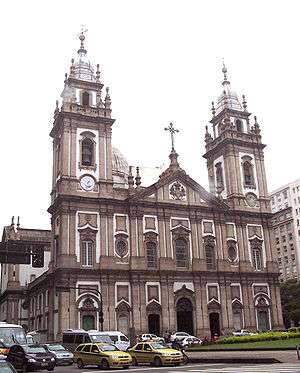Candelária massacre

The Candelária massacre (Portuguese: chacina da Candelária [ʃɐˈsĩnɐ ðɐ kɐ̃deˈlaɾjɐ]) was an event in Rio de Janeiro, beside the Candelária Church, on the night of July 23, 1993. Eight young people were killed by a group of men, several of which were members of the police. The men were tried for the killings, but only two of them were convicted.
The Candelária is a famous Roman Catholic church. The marquises of the buildings around it, in the Pius X Square, are known in Rio de Janeiro for being a makeshift home at night to possibly hundreds of homeless children, many of whom are involved with illegal drug trade and prostitution. The church's personnel provides food, shelter, education and religious advice to as many of these children as possible. Because many of the homeless also live around the Church during the day, police keep a constant vigil on the church's surroundings.
In the early 1990s the area developed a high crime rate as some of the homeless engaged in criminal activities such as pickpocketing, theft, etc.
The massacre
According to survivors, the morning of the day before the massacre, a group of children threw stones at police cars. Some of the policemen allegedly told them, "don't worry, we will get you soon!" As children from the Candelária church were usually given warnings such as these by policemen, the young perpetrators left without worrying too much about the threat.
At midnight, a few cars came to a halt in front of the Candelária church. Next, shots were heard. The children tried to take cover, but eight of them were shot to death and several others wounded. One of the children present that night, Sandro Rosa do Nascimento, later hijacked a bus in an incident that was widely televised throughout all of Brazil.
The international community severely condemned the attack, and many in Brazil asked for the prosecution of those who shot the Candelária church children.
List of those killed
- Paulo Roberto de Oliveira, 11 years old
- Anderson de Oliveira Pereira, 13 years old
- Marcelo Cândido de Jesus, 14 years old
- Valdevino Miguel de Almeida, 14 years old
- "Gambazinho", 17 years old
- Leandro Santos da Conceição, 17 years old
- Paulo José da Silva, 18 years old
- Marcos Antônio Alves da Silva, 20 years old
The aftermath
Eight street children were killed when policemen shot at a group of about seventy street children as they slept beside the Candelária. One of the children that survived that attack was shot several times before he could testify against the military policemen that were to go to trial. He ended up fleeing from Brazil in order to save his life. Three military policemen were charged in the killings, but only one was convicted.
Fifty officers were accused of the massacre. One of them, Mauricio da Conceição, died during a shootout as he was about to be arrested in 1994. Two others, Marcos Emmanuel and Nelson Cunha, were handed sentences equivalent to life sentences. However, they could potentially avoid the imprisonment, as Brazilian law says that anyone who gets a sentence of twenty or more years in jail, automatically qualifies for a second trial.
It has been estimated that 62 street children survived the massacre. A social worker who later tracked the fate of these homeless survivors found out that eventually 39 of them were either killed by police or by elements of street life, and she discusses this in the documentary film Bus 174.
The event also was mentioned in the song The Candelaria Massacre recorded by a Brazilian death metal band Lacerated And Carbonized (from the 2013's album The Core of Disruption).
Sandro Rosa do Nascimento and Bus 174
One of the survivors, Sandro Rosa do Nascimento, later became infamous for hijacking a city bus and standing off with Rio police on June 12, 2000 (Brazilian equivalent of Valentine's Day). During the confrontation, Sandro screamed on television cameras about social injustice in Brazilian society while holding his weapon to a hostage's head. Amidst his threats, he argued that mainstream Brazil ignored the poor and destitute to the point of denying even the humanity of the homeless. The situation lasted for several hours as police and BOPE teams were stifled by politicians reluctant to create a sensational scene on national television. At a certain point, Sandro pretended to kill one of the victims, firing at the floor of the bus and quietly asking the hostage to stay down. While exiting the bus, Sandro was subdued by police after the hostage he was holding was shot (once by an officer in the face, and thrice by Sandro in the back as she fell to the ground) and killed. As the hostage fell to the ground, angry civilian bystanders reacted by hitting and throwing debris at Sandro. Sandro was arrested by police officers but died of asphyxiation within the police vehicle on the way to the police station. The officers were charged with his death but were found not guilty. This face-off between a homeless person and police sparked a debate of the relationship between the homeless and the mainstream in developing countries worldwide. The drama of Sandro’s life and his final hours was portrayed in the critically acclaimed documentary film Bus 174 (English title) and in the 2008 movie Última Parada 174.
See also
External links
- Movie review and director interview
- Amnesty International report and information
- Brazilian trooper convicted of slaughtering street children, CNN.com, May 1, 1996
- Trial begins for Rio police accused of killing homeless kids, CNN.com, December 9, 1996
- Killing of 4 Beggars Shocks Rio And Recalls Earlier Massacre, New York Times, December 12, 1997
Coordinates: 22°54′03″S 43°10′40″W / 22.9009°S 43.1778°W